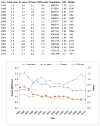Malaria in India: the center for the study of complex malaria in India
- PMID: 22142788
- PMCID: PMC3294179
- DOI: 10.1016/j.actatropica.2011.11.008
Malaria in India: the center for the study of complex malaria in India
Abstract
Malaria is a major public health problem in India and one which contributes significantly to the overall malaria burden in Southeast Asia. The National Vector Borne Disease Control Program of India reported ∼1.6 million cases and ∼1100 malaria deaths in 2009. Some experts argue that this is a serious underestimation and that the actual number of malaria cases per year is likely between 9 and 50 times greater, with an approximate 13-fold underestimation of malaria-related mortality. The difficulty in making these estimations is further exacerbated by (i) highly variable malaria eco-epidemiological profiles, (ii) the transmission and overlap of multiple Plasmodium species and Anopheles vectors, (iii) increasing antimalarial drug resistance and insecticide resistance, and (iv) the impact of climate change on each of these variables. Simply stated, the burden of malaria in India is complex. Here we describe plans for a Center for the Study of Complex Malaria in India (CSCMi), one of ten International Centers of Excellence in Malaria Research (ICEMRs) located in malarious regions of the world recently funded by the National Institute of Allergy and Infectious Diseases, National Institutes of Health. The CSCMi is a close partnership between Indian and United States scientists, and aims to address major gaps in our understanding of the complexity of malaria in India, including changing patterns of epidemiology, vector biology and control, drug resistance, and parasite genomics. We hope that such a multidisciplinary approach that integrates clinical and field studies with laboratory, molecular, and genomic methods will provide a powerful combination for malaria control and prevention in India.
Copyright © 2011 Elsevier B.V. All rights reserved.
Figures


References
-
- Adak T, Kaur S, Singh OP. Comparative susceptibility of different members of the Anopheles culicifacies complex to Plasmodium vivax. Trans R Soc Trop Med Hyg. 1999;93(6):573–577. - PubMed
-
- . Rolling back malaria - the next ten years. Lancet. 2008;372:1193. - PubMed
-
- Carlton JM, Adams JH, Silva JC, Bidwell SL, Lorenzi H, Caler E, Crabtree J, Angiuoli SV, Merino EF, Amedeo P, Cheng Q, Coulson RM, Crabb BS, Del Portillo HA, Essien K, Feldblyum TV, Fernandez-Becerra C, Gilson PR, Gueye AH, Guo X, Kang’a S, Kooij TW, Korsinczky M, Meyer EV, Nene V, Paulsen I, White O, Ralph SA, Ren Q, Sargeant TJ, Salzberg SL, Stoeckert CJ, Sullivan SA, Yamamoto MM, Hoffman SL, Wortman JR, Gardner MJ, Galinski MR, Barnwell JW, Fraser-Liggett CM. Comparative genomics of the neglected human malaria parasite Plasmodium vivax. Nature. 2008;455(7214):757–763. - PMC - PubMed
-
- Dash AP, Adak T, Raghavendra K, Singh OP. The biology and control of malaria vectors in India. Curr Sci. 2007;92:1571–1578.
-
- Dash AP, Valecha N, Anvikar AR, Kumar A. Malaria in India: challenges and opportunities. J Biosci. 2008;33(4):583–592. - PubMed
Publication types
MeSH terms
Substances
Grants and funding
LinkOut - more resources
Full Text Sources
Medical
Molecular Biology Databases

